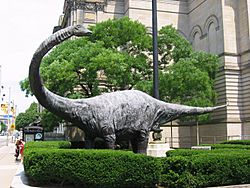Sauropodomorph facts for kids
Quick facts for kids SauropodomorphaTemporal range: Upper Triassic – Upper Cretaceous
|
|
|---|---|
 |
|
| Statue of Diplodocus carnegiei outside the Carnegie Museum | |
| Conservation status | |
|
Fossil
|
|
| Scientific classification | |
| Kingdom: | |
| Phylum: | |
| Class: | |
| Superorder: | |
| Order: | |
| Suborder: |
Sauropodomorpha
von Huene, 1932
|
| Infraorders | |
Imagine a dinosaur so big it shook the ground with every step! That's a good way to think about Sauropodomorpha. These amazing creatures were a special group of dinosaurs. They were known for their huge bodies, long necks, and even longer tails.
Sauropodomorpha were plant-eaters, meaning they were herbivores. They walked on four legs, like many large animals today. This group includes some of the biggest land animals that ever lived!
Scientists divide Sauropodomorpha into two main groups:
- Prosauropods: These were earlier, often smaller, and sometimes walked on two legs.
- Sauropods: These were the true giants, always walking on four legs. Famous sauropods include Diplodocus, Apatosaurus (also known as Brontosaurus), and Argentinosaurus.
Incredible Size
Sauropodomorphs were truly enormous. They were the largest land animals to ever walk the Earth. No other land creature has come close to their massive size.
The only animal alive today that is bigger than these dinosaurs is the modern blue whale. But blue whales live in the ocean, not on land!
One of the biggest sauropods was Argentinosaurus. Its vertebra (a bone from its spine) could be over 1.59 meters (about 5 feet) long! Imagine how big the rest of the dinosaur must have been if just one bone was that huge. These dinosaurs needed their long necks to reach high leaves on trees. Their long tails helped them balance their giant bodies.
Images for kids
-
Skull of Nigersaurus taqueti and how its head might have been held.
-
A drawing of Panphagia, one of the earliest known sauropodomorphs.
-
Plateosaurus is a well-known prosauropod.
See also
 In Spanish: Sauropodomorpha para niños
In Spanish: Sauropodomorpha para niños





